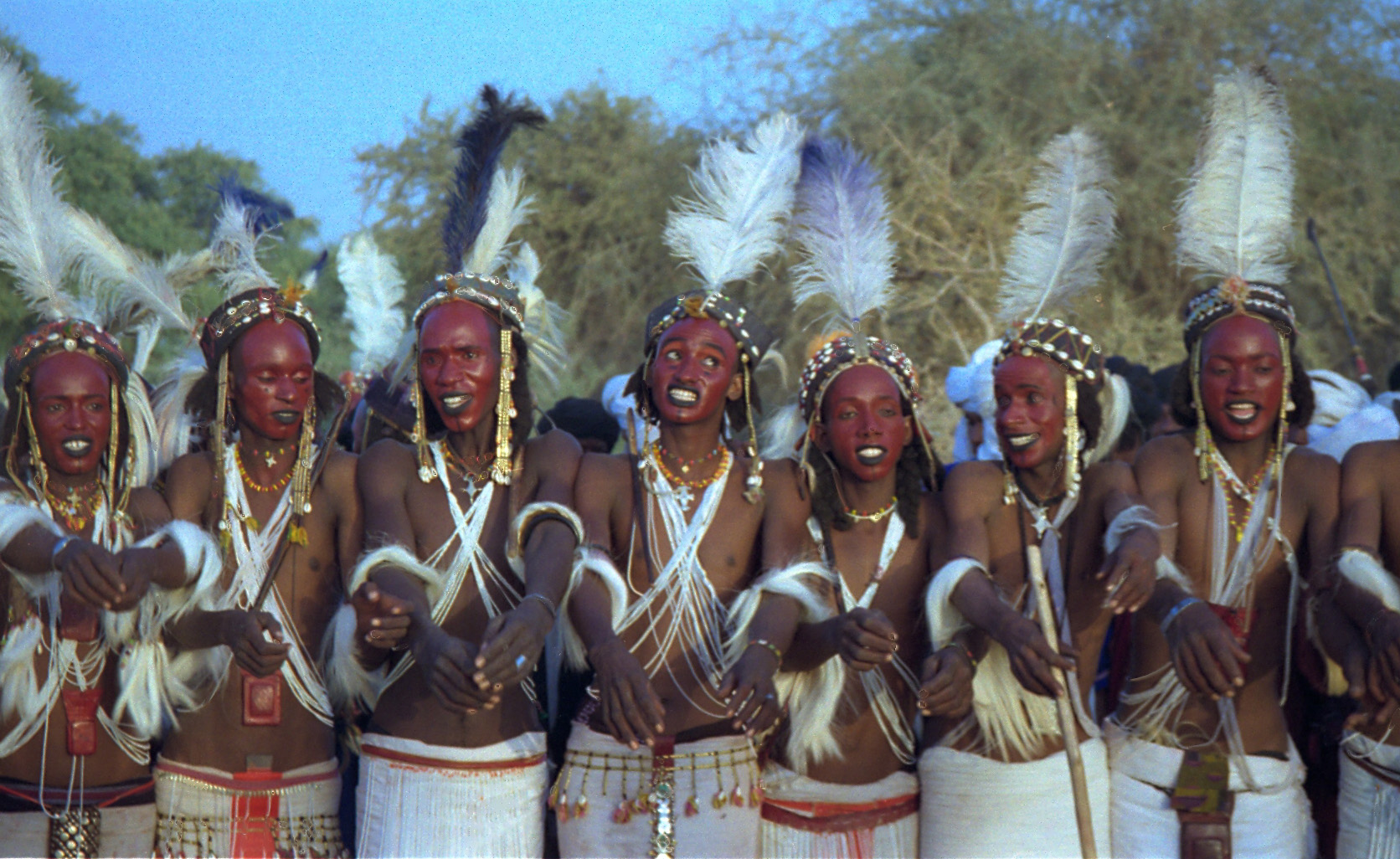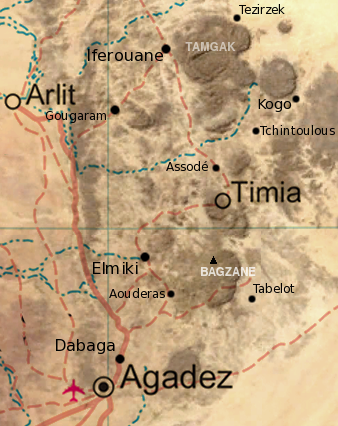|
In-Gall
In-Gall (var. In Gall, I-n-Gall, In-Gal, Ingal, Ingall) is a town in the Agadez Region, Tchirozerine Department of northeast Niger, with a year-round population of less than 500. Known for its oasis and salt flats, In-Gall is the gathering point for the Cure Salee festival of Tuareg and Wodaabe pastoralists to celebrate the end of the rainy season each September. During the festival, In-Gall's population grows to several thousand nomads, officials, and tourists. As of 2011, the commune had a total population of 47,170 people. In-Gall had been a stop on the main roads between the capital of Niger, Niamey (600 km to the southwest), and the mining town of Arlit (200 km to the northeast, 150 km from the Algerian border) or the provincial capital Agadez (100 km to the east). In the 1970s, the main road was repaved to transport uranium from the French-owned mines in Arlit, but the new road bypassed In-Gall, ending its use as a waystation. Since then, its popula ... [...More Info...] [...Related Items...] OR: [Wikipedia] [Google] [Baidu] |
Tuareg People
The Tuareg people (; also spelled Twareg or Touareg; endonym: ''Imuhaɣ/Imušaɣ/Imašeɣăn/Imajeɣăn'') are a large Berber ethnic group that principally inhabit the Sahara in a vast area stretching from far southwestern Libya to southern Algeria, Niger, Mali, and Burkina Faso. Traditionally nomadic pastoralists, small groups of Tuareg are also found in northern Nigeria. The Tuareg speak languages of the same name (also known as ''Tamasheq''), which belong to the Berber branch of the Afroasiatic family. The Tuaregs have been called the "blue people" for the indigo dye coloured clothes they traditionally wear and which stains their skin. They are a semi-nomadic people who practice Islam, and are descended from the indigenous Berber communities of Northern Africa, which have been described as a mosaic of local Northern African ( Taforalt), Middle Eastern, European (Early European Farmers), and Sub-Saharan African-related ancestries, prior to the Arab expansion. Tuareg people ... [...More Info...] [...Related Items...] OR: [Wikipedia] [Google] [Baidu] |
Niger
) , official_languages = , languages_type = National languagesRépublique du Niger, "Loi n° 2001-037 du 31 décembre 2001 fixant les modalités de promotion et de développement des langues nationales." L'aménagement linguistique dans le monde (accessed 21 September 2016) , languages = , religion_ref = , religion_year = 2012 , religion = , demonym = Nigerien , capital = Niamey , coordinates = , largest_city = Niamey , government_type = Unitary state, Unitary Semi-presidential s ... [...More Info...] [...Related Items...] OR: [Wikipedia] [Google] [Baidu] |
Wodaabe
The Wodaabe ( ff, Woɗaaɓe, Adlam: ), also known as the Mbororo or Bororo (Adlam: , ), or Pullo, have a name that is designated to those of the Fula ethnic group who are traditionally nomadic and considered to be "ignorant of Islam." For this reason, ''Mbororo'' is normally used as a derogatory term by other Fulani groups against the Wodaabe. It is translated into English as "Cattle Fulani", and meaning "those who dwell in cattle camps". The Wodaabe culture is one of the 186 cultures of the standard cross-cultural sample used by anthropologists to compare cultural traits. A Wodaabe woman, Hindou Oumarou Ibrahim, was also chosen to represent civil society of the world on the signing of Paris Protocol on 22 April 2016. History The Wodaabe are cattle-herders and traders in the Sahel, with migrations stretching from southern Niger, through northern Nigeria, northeastern Cameroon, southwestern Chad, western region of the Central African Republic and the northeastern of the Demo ... [...More Info...] [...Related Items...] OR: [Wikipedia] [Google] [Baidu] |
Agadez Region
Agadez Region is one of the seven regions of Niger. At , it covers more than half of Niger's land area, and is the largest region in the country, as well as the largest African state subdivision. The capital of the department is Agadez. History The region is a centre for palaeontology, with numerous dinosaur skeletons being found here, including the '' Ouranosaurus nigeriensis''. Cave painting and the remains of ancient human settlements are also located here. Tuareg peoples began migrating to the region from the mid-8th century. From the mid-15th century to the early 20th, much of the region was under the control of the Sultanate of Agadez, except for a period when the area came under the rule of the Songhai Empire in the 1500s. The region suffered with the advent of French colonialism as power shifted away to the southwest; Tuareg disaffection with French rule resulted in the Kaocen revolt in 1916–17. This process continued following Niger's independence in 1960; local T ... [...More Info...] [...Related Items...] OR: [Wikipedia] [Google] [Baidu] |
Azawagh
The Azawagh (alias ''Azaouagh'' or ''Azawak'') is a dry structural basin, basin covering what is today the northwestern Niger, as well as parts of northeastern Mali and southern Algeria. The Azawagh is mainly made up of Sahelian and Saharan flatlands and has a population that is predominantly Tuareg people, Tuareg, with some Arabic-speaking, Bouzou and Wodaabe minorities and a recent influx of Hausa people, Hausa and Zarma people, Zarma. Name The Tuareg languages, Tuareg word ''azawaɣ'' means "savannah". Azawad, a term used for the portion of northern Mali claimed by the Tuareg rebel movement National Movement for the Liberation of Azawad, is believed to be an Arabic corruption of "Azawagh". Geography The Azawagh refers to the dry structural basin, which once carried a northern tributary of the Niger River, the Azawagh river, known as Dallol Bosso further south. The river, which ran some in prehistoric times, dried up after the Neolithic Subpluvial and created a basin o ... [...More Info...] [...Related Items...] OR: [Wikipedia] [Google] [Baidu] |
Arlit
Arlit is an industrial town and capital of the Arlit Department of the Agadez Region of northern-central Niger, built between the Sahara Desert and the eastern edge of the Aïr Mountains. It is 200 km south by road from the border with Algeria. As of 2011, the commune had a total population of 112,432 people. Uranium industry Founded in 1969 following the discovery of uranium, it has grown around the mining industry, developed by the French government. Two large uranium mines, at Arlit and nearby Akouta, are exploited by open top strip mining. One open pit mine was built in 1971 by the National Mining Company of Niger, SOMAIR. The Second open pit mine, as well as a third underground mine, was built by the French Compagnie Minière d'Akouta (or COMINAK). All the ore from both is now processed and transported by a French company Orano Cycle, a holding of the Orano group, itself a state owned operation of the French ''Commissariat à l'énergie atomique'' (CEA). The ... [...More Info...] [...Related Items...] OR: [Wikipedia] [Google] [Baidu] |
Cure Salee
The Cure Salée (French: "Salt Cure"), or "Festival of the Nomads", is a yearly gathering of the Tuareg and Wodaabe peoples in the northern Niger town of In-Gall. The ceremony marks the end of the rainy season, and usually occurs in the last two weeks of September. The government of Niger began sponsoring the festival in the 1990s, fixing its date for each year (in 2006: September 11), its duration (three days), and bringing in dignitaries, performers, and tourists. Traditions The end of the rainy season is an especially important event in the lives of Saharan pastoralists. Tuareg clans gather at the salt flats and pools near Ingall to refresh their cattle and goat herds, and to prepare for the trip further south so they can survive the dry season. The Cure Salée is also believed to benefit the local people, and medicinal cures are a major part of the festival. However, the Cure Salée is as just as important as a social gathering. After a season in dispersed clan groups, there ... [...More Info...] [...Related Items...] OR: [Wikipedia] [Google] [Baidu] |
Niger River
The Niger River ( ; ) is the main river of West Africa, extending about . Its drainage basin is in area. Its source is in the Guinea Highlands in south-eastern Guinea near the Sierra Leone border. It runs in a crescent shape through Mali, Niger, on the border with Benin and then through Nigeria, discharging through a massive delta, known as the Niger Delta (or the Oil Rivers), into the Gulf of Guinea in the Atlantic Ocean. The Niger is the third-longest river in Africa, exceeded by the Nile and the Congo River. Its main tributary is the Benue River. Etymology The Niger has different names in the different languages of the region: * Fula Fula may refer to: *Fula people (or Fulani, Fulɓe) *Fula language (or Pulaar, Fulfulde, Fulani) **The Fula variety known as the Pulaar language **The Fula variety known as the Pular language **The Fula variety known as Maasina Fulfulde *Al-Fula ...: ''Maayo Jaaliba'' * Manding: ''Jeliba'' or ''Joliba'' "great riv ... [...More Info...] [...Related Items...] OR: [Wikipedia] [Google] [Baidu] |
Kel Fadey
Kel or KEL may refer to: * Raquel Calderón (born 1991), Chilean singer and actress * Kei Lun stop, Hong Kong, MTR station code KEL * Kel, Azad Kashmir, village in Neelam Valley, Azad Kashmir, Pakistan * Kel Mitchell (born 1978), American actor and comedian * KEL, the IATA airport code for Kiel Airport in Germany * KEL Company Kerala Electrical and Allied Engineering Company * Κel, elimination rate constant in pharmacological clearance * KEL, a gene in the Kell antigen system The Kell antigen system (also known as the Kell–Cellano system) is a human blood group system, that is, a group of antigens on the human red blood cell surface which are important determinants of blood type and are targets for autoimmune or a ... * KEL, a character in the 2020 role-playing video game '' OMORI'' See also * Kell (other) {{Disambig, given name, airport ... [...More Info...] [...Related Items...] OR: [Wikipedia] [Google] [Baidu] |
Regions Of Niger
Niger is divided into eight regions (French: ''régions;'' singular''région)'', each of which is named after its capital. Current regions *Additionally, the national capital, Niamey, comprises a special capital district. Current administrative structure Each of Niger's regions are subdivided into departments and communes. As of 2005, there were 36 ''départements'', divided into 265 communes, 122 cantons and 81 ''groupements''. The latter two categories cover all areas not covered by urban communes (population over 10000) or rural communes (total population 13 million), and are governed by the department, whereas communes have had elected councils and mayors since 1999. Additional semi-autonomous subdivisions include sultanates, provinces and tributaries (''tribus''). The Nigerien government estimates there are an additional 17000 villages administered by rural communes, while there are a number of ''quartiers'' (boroughs or neighborhoods) administered by urban communes. ... [...More Info...] [...Related Items...] OR: [Wikipedia] [Google] [Baidu] |
Songhay Empire
The Songhai Empire (also transliterated as Songhay) was a state that dominated the western Sahel/Sudan in the 15th and 16th century. At its peak, it was one of the largest states in African history. The state is known by its historiographical name, derived from its leading ethnic group and ruling elite, the Songhai. Sonni Ali established Gao as the capital of the empire although a Songhai state had existed in and around Gao since the 11th century. Other important cities in the empire were Timbuktu and Djenné, conquered in 1468 and 1475 respectively, where urban-centered trade flourished and to the south is the north Akan state of Bonoman. Initially, the empire was ruled by the Sonni dynasty (–1493), but it was later replaced by the Askia dynasty (1493–1901). During the second half of the 13th century, Gao and the surrounding region had grown into an important trading center and attracted the interest of the expanding Mali Empire. Mali conquered Gao towards the end of ... [...More Info...] [...Related Items...] OR: [Wikipedia] [Google] [Baidu] |



%2C_scene_at_the_river_front.jpg)
